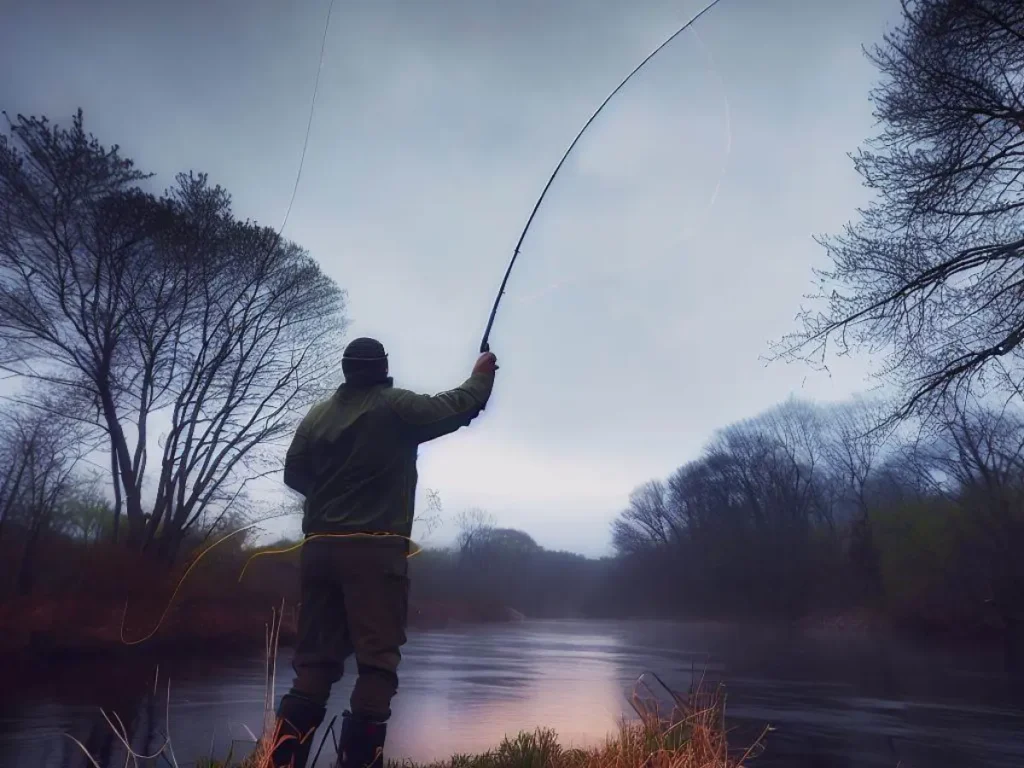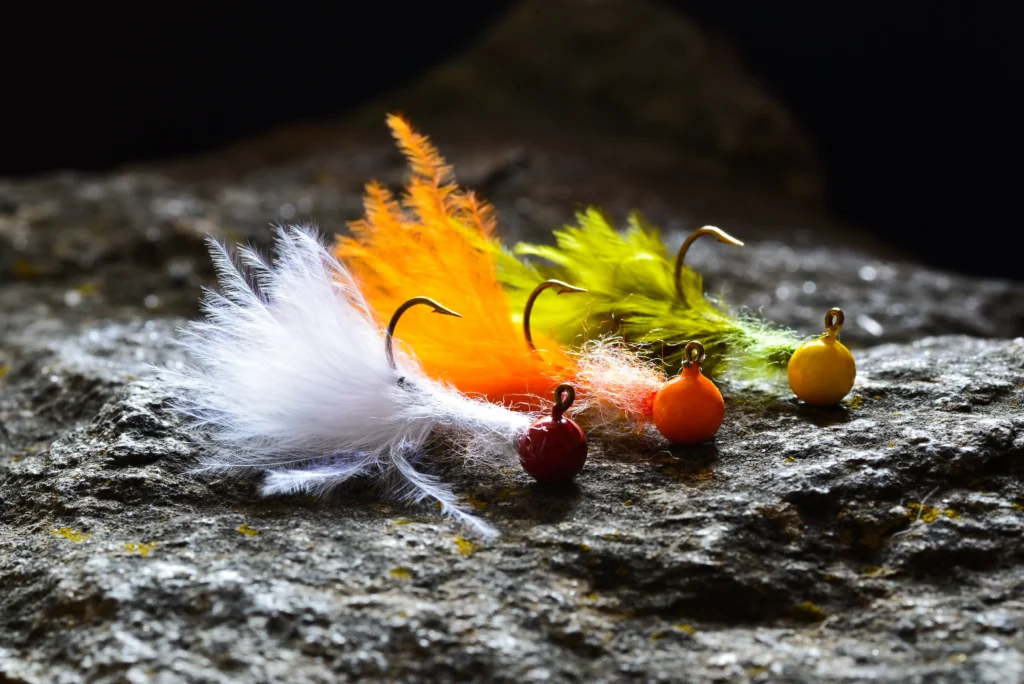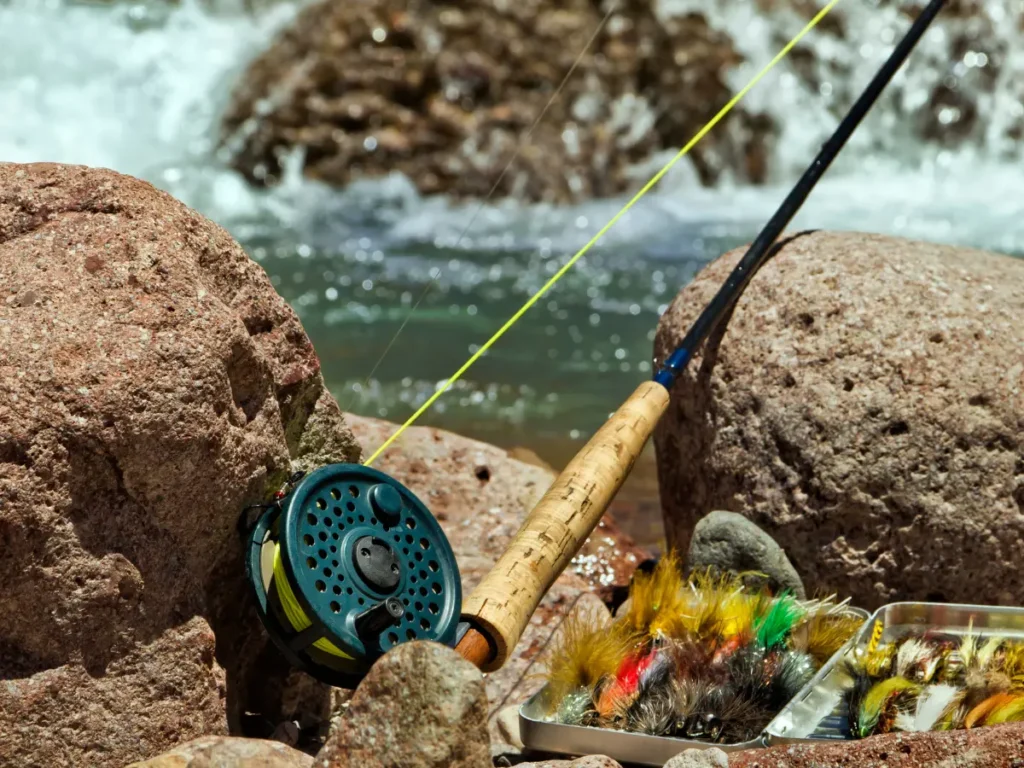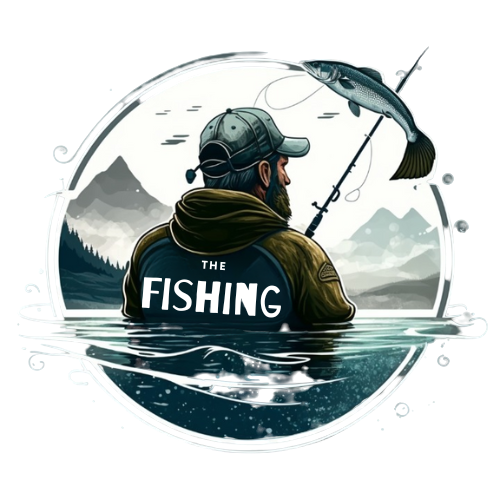Fly fishing is a popular form of angling that uses flies to simulate the natural food of the fish, rather than using bait or lures. One specific technique used in fly fishing is called streamer fishing. But, what is a streamer in fly fishing?
In this comprehensive guide, I will delve into the world of fly fishing streamers and explain their importance, targeting techniques, rod selection, and the best ways to use streamers for catching big fish.

Table of Contents
- So, What is a streamer in fly fishing?
- Is streamer fishing really fly fishing?
- When Should You Use Streamers?
- What is the difference between a streamer and other flies
- Types of Streamers in Fly Fishing
- Understanding Fish Life Cycles and Why Big Fish Eat Streamers
- What Type Of Rod and line Should You Choose For Fly Fishing Streamers?
- Streamer Fishing in Different Water Conditions
- Why Are Streamers So Effective For Finding Trout?
- What Streamers To Use for Trout?
- Streamer Fishing Tactics for Specific Species
- Tips for Fly Fishing Streamers
- Final Thoughts
So, What is a streamer in fly fishing?
Streamers in fly fishing are larger, elongated flies made from a combination of materials like feathers, fur, and synthetic fibers. They often feature vivid colors and lifelike designs to closely resemble the appearance and movement of prey species such as baitfish, leeches, and crayfish in the water.
They are particularly effective for catching aggressive trout and other species and are often used to target bigger fish.
Is streamer fishing really fly fishing?
Yes, streamer fishing is fly fishing.
Streamer fishing is a subcategory of fly fishing that involves using streamers to imitate larger prey items like baitfish, leeches, and crayfish. While it may differ from other traditional fly fishing techniques like dry fly fishing and nymphing, streamer fishing still falls within the broader category of fly fishing.
One key aspect that defines fly fishing is that flies are used as the primary method of attracting fish.
While other lures and bait types are often used in conventional fishing, fly fishing relies on the artful presentation of flies to mimic natural prey items. In this context, streamer fishing is no different; streamers are larger flies designed specifically to entice fish to strike.
Overall, although streamer fishing may represent a different approach within the realm of fly fishing, it is still fundamentally linked to the core principles and methods of this popular angling discipline.
When Should You Use Streamers?

Fishing streamers are most effective when other methods of dry fly fishing or nymphing aren’t producing results or when you are targeting larger fish. In particular, it is especially helpful during the early spring and fall months when fish are more aggressive and feed on larger prey, such as bait fish.
Additionally, streamer anglers can find success during periods of low light, such as dawn, dusk, and overcast days, as well as during night fishing when fish are more likely to be feeding on larger prey.
What is the difference between a streamer and other flies
| Type of Fly | Fishing Technique | Target Species |
|---|---|---|
| Streamer | Cast and retrieved, often with a strip or twitching technique; can be fished near the surface, mid-depth, or along the bottom. | Predatory fish such as trout, bass, pike, and salmon. |
| Wet Fly | Typically cast across or slightly downstream and allowed to drift or swing in the current, with a more subtle retrieve. | Trout, grayling, and other insect-feeding fish species. |
| Dry Fly | Cast and presented with a delicate landing on the water, typically drifting naturally with the current to imitate a floating insect. | Trout, grayling, and other surface-feeding fish species. |
| Nymph | Cast either upstream, downstream, or across, with a dead drift or slight retrieve used to imitate the natural movement of nymphs. | Trout, grayling, and other fish species that feed on nymphs. |
Types of Streamers in Fly Fishing

Fly fishing involves various techniques, and one of the most diverse and effective methods is the use of streamers. These versatile flies can be tied in a wide range of sizes, colors, and patterns to match the specific type of prey in your target waters. In this article, we will discuss several types of streamers commonly used in fly fishing and the situations in which they excel.
Wooly Bugger:
Wooly Buggers are the best flies and arguably the most popular and versatile streamers in fly fishing. These simple yet effective flies can be tied in a multitude of colors and sizes to imitate a variety of aquatic species, from baitfish and leeches to crayfish and large insects.
They are ideal for various conditions and can effectively attract trout, bass, and other fish species.
Likely the most well-known and versatile streamer fly, the wooly bugger can mimic various natural prey, making it an excellent choice for fly fisherman for catching fish in various conditions. They come in many colors and sizes, allowing for adaptability in different waters.
Sculpin Patterns:
Sculpin patterns are designed to imitate small, bottom-dwelling fish often found in rivers and streams. Sculpins provide an essential food source for various fish species, making sculpin imitations a useful addition to any fly angler’s fly box.
These patterns are typically tied with a large, broad head that helps create a natural swimming action in the water.
Muddler Minnows:
Muddler Minnows are classic streamers that have been used for decades by fly fishers targeting a variety of species.
These flies are tied with a spun deer hair head and various body materials to imitate baitfish. Muddler Minnows can also be used to mimic other prey items like insects big flies and crustaceans, making them a great option for diverse streamer fishing scenarios.
Zonker Patterns:
Zonker streamers feature a rabbit fur strip that creates a lifelike, undulating action in the water, effectively imitating the movement of small baitfish. Zonkers come in various colors and variations, including articulated versions that provide additional movement and attract even more fish.
Articulated Streamers:
Articulated streamers are large flies composed of two or more hook sections attached by wire or monofilament, creating a flexible, lifelike action in the water.
These streamers are perfect for targeting large, predatory fish such as brown trout and bass, as their size and realistic movement can trigger aggressive strikes from biggest fish.
Clouser Minnows:
Clouser Minnows are a staple fly pattern for many fly anglers looking to imitate baitfish.
Tied with dumbbell eyes for added weight, Clouser Minnows features an inverted design that helps them swim near the bottom without snagging, making them a popular choice for fishing in deeper waters.
Deceiver Patterns:
Deceiver flies are long, slender streamers that imitate baitfish, making them effective in catching trout in both fresh and saltwater environments.
These flies can be tied in a variety of colors and sizes to match the specific baitfish species found in the waters you’re fishing.
Streamers are an indispensable part of a fly angler’s arsenal, providing the ability to imitate a wide range of prey species and target various water depths and conditions. By familiarizing yourself with the different types of streamers detailed in this article, you will be better equipped to match the hatch and effectively target your desired fish species.
Understanding Fish Life Cycles and Why Big Fish Eat Streamers
Both inexperienced most anglers and veteran fly fishers can benefit from understanding the various stages of fish life cycles and the reasons why large fish like big fish are attracted to streamer flies.
Understanding fish life cycles will aid you in selecting the right fish streamers to imitate the prey of the fish during different times of the year.
Simply put, big fish often see struggling baitfish eat small fish. Large predatory fish like brown trout are more likely to go for smaller fish when food resources are limited, making streamers an effective way to mimic bait fish and catch their attention.
Trout streamers also mimic other prey items like crustaceans, leeches, or large aquatic insects, which can all be found in a brown trout’s diet.
What Type Of Rod and line Should You Choose For Fly Fishing Streamers?
Choosing the right rod for fly fishing streamers is essential.
Read more: Can you fly Fish with a spinning rod?
A fast-action rod with a stiff backbone is typically recommended for casting streamer flies. A length of eight to nine feet works well for most situations, with a 6 to 8 weight being ideal for casting larger and heavier streamers.

A high-quality fly line is also essential for efficiently casting streamers and landing larger fish.
When selecting a fly line, opt for a weight-forward or shooting taper line designed specifically for streamer fishing. These lines will help you accurately cast heavy and air-resistant flies while still maintaining a delicate presentation.
Additionally, having a sink tip or sinking line is beneficial when fishing deep water, as it helps to get your streamer down to the desired depth faster.
Streamer Fishing in Different Water Conditions
When fishing streamers, adapting your technique to different water conditions is essential. Here are some tips for fishing streamers in various scenarios.
Streamer Technique In Choppy Waters:
One of the challenges of fly fishing streamers in choppy waters is maintaining control of your fly and line. When casting into choppy waters, it’s crucial to keep your rod tip low and close to the water’s surface to minimize the effects of wind or currents on your fly hang line.
To effectively use a streamer in choppy waters, try employing an active retrieve technique. Use a combination of strip retrieves and rod-twist retrieves to impart action on your streamer and keep it in the strike zone as long as possible. This will entice fish from a greater distance and give them more opportunities to strike your fly.
Streamer Technique In Shallow Water:
In shallower water, use smaller, lighter streamers and a floating line to avoid snagging on the bottom. Cast upstream and maintain a tight line as your streamer drifts downstream.
Streamer Technique In Deep Water:
When fishing deep water, use a sinking tip or full sinking line to get your streamer down to the desired depth. Weighted streamers can also help you reach the largest fish even in deeper waters. Make sure to impart action on your fly with strategic retrieves that resemble the swimming patterns of prey.
Streamer Technique In Clear Water:
In clear water, consider using more natural or subdued fly colors and patterns that more closely resemble the natural prey found in the environment. Be mindful of your stealth approaches, as fish can be spooked by angler movement more easily in clear water conditions.
Why Are Streamers So Effective For Finding Trout?
Fly fishing streamers are an effective method for finding and catching fish, especially larger fish such as brown and rainbow trout.
Unlike dry flies or nymphs that imitate specific insects at various stages of their life cycle, streamers mimic small prey fish, leeches, or crustaceans that larger fish feed on.
Fish like large brown trout are opportunistic predators and often hold in deeper water waiting for smaller fish to swim by. By using fly fishing streamers, you can effectively cover more water and target these predatory fish.
Streamers can be fished along the bottom of drift boat or throughout the entire water column, giving you the ability to target fish at different depths.
The aggressive nature of streamers also makes them effective in finding fish. The movement and vibration created by the streamer entice fish to strike out of curiosity or aggression, even if they’re not actively feeding.
What Streamers To Use for Trout?
There is a vast array of fly fishing streamers available for trout, ranging from small, simple patterns to large, articulated flies.
Some popular and effective streamer patterns for trout include:
- Wooly Buggers: A versatile pattern that can be tied in a variety of colors and sizes to imitate a variety of prey.
- Sculpins: Often found in trout streams, sculpins are a favorite meal of many trout species. Patterns that mimic sculpins are great at triggering aggressive strikes.
- Muddler Minnows: Originally designed to imitate a bait fish, this versatile pattern can also be used to imitate other prey species.
- Zonkers: A rabbit fur strip streamer that has great fluttering action in the water.
- Articulated Flies: Large, often flashy patterns made up of two or more hook sections that are connected by a wire or monofilament. These flies create a lifelike swimming action in the water, making them irresistible to big fish.
Read more: Is fly fishing only for trout?
Streamer Fishing Tactics for Specific Species
Understanding the preferred habits and environment of different streamer fish and species is essential when adapting your streamer fishing tactics.
- Pike: Pike are aggressive, ambush predators with an inclination for attacking larger prey. When targeting pike with streamers, choose large, articulated patterns that mimic baitfish or even smaller pike. Cast your streamers near weed beds, drop-offs, and other structures where pike are likely to hide. Utilize fast retrieves with occasional pauses to trigger strikes from these opportunistic predators.
- Bass: Bass is highly adaptable predators known for striking a wide variety of prey, making them an ideal species for streamer fishing. Popular streamer patterns for bass include Wooly Buggers, Clouser Minnows, and crayfish imitations. Focus on fishing around structures, like docks, submerged trees, and grass beds, where bass tend to hold and ambush their prey. Experiment with different retrieve speeds and depths to find what works best under current conditions.
- Salmon: Streamers fishing for salmon should focus on imitating available prey species like smaller fish and shrimp during their time in freshwater. Alaskan salmon, for example, may respond well to patterns like egg-sucking leeches, bunny leeches, or traditional Pacific salmon patterns. It’s crucial to consider the stage of the salmon’s life cycle, as well as their feeding habits when choosing your streamer tactics. Pay attention to the current, targeting seams and slower water, where salmon are more likely to hold.
- Trout: Trout are opportunistic feeders, and streamers can be an excellent way to trigger a predatory response from them. Using streamers that resemble local baitfish, leeches, or even crayfish can yield great results. Patterns like Wooly Bugger, Sculpin imitations, and articulated leeches can be particularly effective in various situations. Fish structure and depth changes can result in finding more trout, as they often hang out near boulders, undercut banks, or pools.
By honing your streamer fishing tactics to specific species, you can greatly increase your success on the water. Consider the unique behaviors, habitats, and prey preferences of each species when selecting your streamers, fishing locations, and retrieval techniques. With practice and observation, you will learn to adapt your approach to effectively target and catch a diverse range of fish species using streamers.
Tips for Fly Fishing Streamers
Here are 10 essential tips for fishing streamers that will help you to catch big fish and more fish:
- Vary Your Retrieve: Mix up your retrieve speed and style to find what works best for the fish on any given day. Experiment with quick, erratic strips, slow and steady retrieves, or a combination of both.
- Cover Water: Streamers excel at covering water efficiently, increasing your chances of finding fish. Make sure to target various depths and structures when fishing.
- Use a Tippet: Using a strong, abrasion-resistant tippet material will help prevent break-offs when casting heavy streamers or targeting more aggressive fish.
- Adjust Your Cast: When casting heavy streamers, it’s essential to adjust your casting technique to accommodate the additional weight and air resistance. Use a slower, more deliberate casting stroke, and open up your casting loop to prevent tangles and improve accuracy.
- Fish Structure: Trout often hold in or near structures, such as downed trees, weed beds, or boulders. Make sure to cast your streamers near these areas, allowing your fly to swim past the structure, imitating a bait fish in its natural environment.
- Experiment with Fly Patterns: Don’t be afraid to switch up your streamer patterns if you’re not getting any action. Try different colors, sizes, and styles until you find what the fish are responding to that day.
- Control Your Line: Keeping your fly line under control is essential when fishing streamers. Use a rod tip low method, keeping your rod tip close to the water, and stripping in a slack line quickly to maintain a tight connection to your fly.
- Utilize a Floating Line with a Sinking Tip: A floating line with a sinking tip can make it easier to control your depth when fishing streamers, allowing you to cover a variety of water depths and conditions.
- Fish Deep: Don’t be afraid to fish deep when fishing streamers. Trout often hold in deeper water, and getting your fly deep can increase your chances of hooking into a trophy.
- Dead Drift: While many anglers use an active retrieve with streamers, trying a dead drift can sometimes be equally effective, particularly in slower, clear water where fish might be more wary.
- Target Big Fish: If you’re looking to catch a big brown trout, streamers are the way to go. Trophy-sized trout are more likely to feed on bait fish or other larger prey items, making streamers the ideal fly choice for enticing a monster brown.
Read also: Difference between fly fishing and reglar fishing
Final Thoughts
With a keen understanding of what a streamer is in fly fishing and the various techniques used with streamers, you can increase your success in targeting and catching larger fish like brown trout. Remember to experiment with different retrieves, fly patterns heavy flies, and water depths to determine what works best for the conditions on any given day.
Do not be afraid to step out of your comfort zone and challenge yourself by casting heavy streamers large trout in challenging conditions. The reward of catching a beautiful, trophy-sized trout on a well-crafted streamer is definitely worth the effort.
In summary, streamers offer a highly effective method for catching big fish in various water conditions and environments. Familiarize yourself with different types of streamer flies and techniques outlined in this guide, and you’ll be well on your way to reeling in some truly memorable catches.
